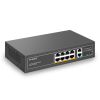So, I again have POE problems.
Current network:
2x HIKVISION DS-2CD2142FWD-I
1x MC500L_AF brand unknown
1x IPD-E2A5L18 perhaps Boavision 20xzoom 5 MP camera
1x Mokerlink 8 port POE switch:

 www.mokerlink.com
www.mokerlink.com
1x Netgear GS305P-100PES 5-port PoE
LAN cables are either installation LAN cables or CAT7 cables, 10 and 15 meters:
I had camera reboots on the Netgear switch. I used installation LAN cables for connection, self made.
Because of the POE troubles I had to add passive POE injectors: Cudy POE200 30W Gigabit PoE+ Injector
I now replaced the Netgear switch with the Mokerlink and the bought CAT7 cables 1x10m and 2x15m.
I again noticed camera reboots, especially in the night, but not in daytime.
Could you help me getting rid of the POE problems?
Why do these happen?
Current network:
2x HIKVISION DS-2CD2142FWD-I
1x MC500L_AF brand unknown
1x IPD-E2A5L18 perhaps Boavision 20xzoom 5 MP camera
1x Mokerlink 8 port POE switch:

MokerLink 8 Port PoE Switch with 2 Gigabit Uplink
MokerLink 8 Port PoE Switch with 2 Gigabit Uplink
1x Netgear GS305P-100PES 5-port PoE
LAN cables are either installation LAN cables or CAT7 cables, 10 and 15 meters:
I had camera reboots on the Netgear switch. I used installation LAN cables for connection, self made.
Because of the POE troubles I had to add passive POE injectors: Cudy POE200 30W Gigabit PoE+ Injector
I now replaced the Netgear switch with the Mokerlink and the bought CAT7 cables 1x10m and 2x15m.
I again noticed camera reboots, especially in the night, but not in daytime.
Could you help me getting rid of the POE problems?
Why do these happen?

